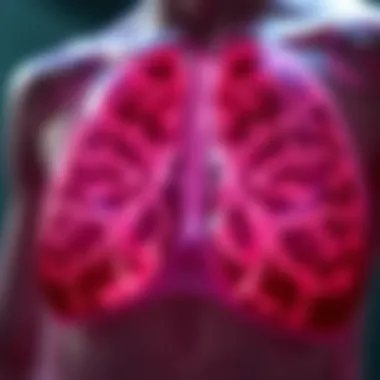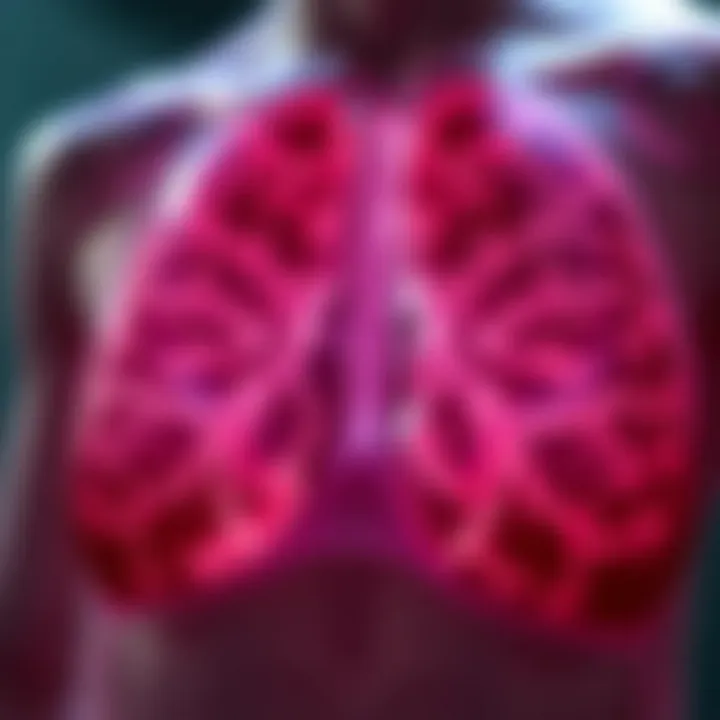Understanding Breast Cancer's Final Stages and Care


Intro
Overview of Research Topic
Brief Background and Context
Historically, breast cancer has been a focal point of cancer research. It's vital to grasp that the journey through stages of cancer is not linear. The fourth stage is considered the advanced stage of breast cancer, characterized by metastasis, or the spread of cancer cells to other organs. Patients may experience symptoms ranging from intense fatigue to severe pain. Additionally, as treatments evolve, so do the approaches to palliative care, which seek to enhance the overall wellbeing of those undergoing late-stage care.
Importance in Current Scientific Landscape
In recent years, understanding the intricacies of advanced breast cancer has garnered increased attention. With the rise of personalized medicine, healthcare professionals are striving to provide tailored treatment options. As we delve into this subject, it's crucial to appreciate how patient-centric approaches can significantly improve life quality. The information presented serves not only those affected by the disease but also contributes to broader scientific discussions about optimizing care strategies.
Methodology
Research Design and Approach
The methodology employed in exploring end-stage breast cancer encompasses a comprehensive literature review and qualitative research involving real-life case studies. This approach ensures a well-rounded understanding of the symptoms, treatment options, and supportive strategies pertinent to patients and families facing this grave diagnosis.
Data Collection Techniques
Data was collected primarily through interviews with healthcare professionals and families affected by breast cancer as well as through reviewing existing medical literature. Public domain resources, including research articles and government health websites, were consulted to ensure the accuracy and relevance of the findings.
Understanding the end-of-life experience in breast cancer involves recognizing not only the physiological changes but also the emotional support networks that can play a crucial role in the journey.
In summary, the exploration of the end stages of breast cancer is not merely an examination of physical symptoms. It reflects an intricate interplay of emotional resilience, treatment nuances, and the harsh realities faced by patients and families. This narrative aims to unravel these layers, providing a thorough understanding while fostering empathy and informed decision-making.
Overview of Breast Cancer Stages
Breast cancer is not just one singular disease; it progresses in stages, each one bearing its own characteristics, symptoms, and treatment protocols. Understanding these stages is crucial for patients, caregivers, and healthcare providers alike. Staging provides insight into how far the cancer has spread, which directly influences the treatment options available and the overall prognosis. Knowledge of the stages can empower patients to make informed decisions about their care and navigate the complexities of treatment effectively.
This article delves into the details, aiming to shed light on the importance of breast cancer staging. By elucidating each stage, we can better appreciate the advancements in medical science that help fight this disease, all while recognizing the emotional and psychological weight that a diagnosis carries.
Prelude to Breast Cancer Staging
Breast cancer staging is a systematic approach that categorizes cancer based on its severity and spread. The widely accepted system is the TNM classification, established by the American Joint Committee on Cancer (AJCC). Here, the "T" represents the size of the primary tumor, "N" indicates whether cancer has spread to nearby lymph nodes, and "M" denotes the presence of metastasis, or distant spread of the cancer.
Each breast cancer diagnosis begins with an assessment of these factors. For example, a T1N0M0 stage refers to a small tumor that hasn’t spread to lymph nodes or distantly to other organs, whereas a T4N3M1 stage signifies a larger, more aggressive tumor with significant spread. This staging is not only a tool for classification but also serves as a compass guiding healthcare providers to the most effective treatment strategies.
An effective understanding of staging provides clarity, allowing patients and their families to know what to expect as the disease progresses. It highlights the gravity of the situation, yet it also reflects the various pathways for treatment and support that unique individuals may take.
The Importance of Staging in Treatment
Staging breast cancer is not just a dry, clinical exercise; it holds significant implications for treatment. Here are a few key benefits of understanding breast cancer stages:
- Customized Treatment Plans: Knowledge of the stage allows oncologists to tailor treatment plans. For instance, early stages may be treated with localized therapies like surgery and radiation, while advanced cases might necessitate systemic treatments such as chemotherapy or targeted therapies.
- Prognostic Information: Stages provide insights into survival rates and potential outcomes, helping both patients and families prepare for the journey ahead. Grasping the realities of different stages can help in emotional preparedness.
- Clinical Trials Eligibility: Understanding the stage of breast cancer can open doors to clinical trials designed for specific stages, potentially offering patients access to cutting-edge therapies that might not be available through traditional treatment routes.
In essence, the stages act as a framework to navigate the often murky waters of breast cancer. From diagnosis to treatment approaches, the information gleaned from staging is indispensable, not only for clinical purposes but also for addressing the emotional and psychological aspects of living with breast cancer.
"Knowledge is power. The more a patient knows about their condition, the more empowered they feel to participate in their own care."
In an era where precision medicine is becoming more prevalent, understanding the stages of breast cancer is vital. It enables a shift from a one-size-fits-all approach to a more personal, tailored strategy that recognizes individual circumstances. This can lead to better outcomes and a more hopeful perspective for those facing end-stage breast cancer.
Characteristics of Advanced Breast Cancer
The characteristics of advanced breast cancer aren’t just medical facts or clinical indicators; they represent a complex intersection of biological processes and human experiences. Patients and caregivers must navigate these changes with empathy and knowledge, thus making it crucial to understand what these characteristics entail.
Defining the Advanced Stages
/
Advanced breast cancer typically refers to stages three and four. At this point, the cancer has moved beyond the localized area of the breast and nearby lymph nodes. In stage three, the cancer may have spread to lymph nodes in the chest wall or underarm but not to distant sites. By stage four, known as metastatic breast cancer, the cells have infiltrated other organs, such as the bones, liver, or lungs. This dissemination alters everything about the illness—from symptoms to treatment options.
Here, clarity is essential: defining these advanced stages is not merely about classification but about understanding the clinical realities faced by patients. The onset of stage four can create a sense of urgency regarding care adjustments, necessitating in-depth discussions about treatment pathways that prioritize comfort and quality of life. \r\n


Common Symptoms Experienced
/
As the disease advances, individuals may experience a host of symptoms that can vary significantly among patients. Unfortunately, these stages bring a more complicated symptom profile, which can include:
- Fatigue: Profound tiredness that doesn’t improve with rest.
- Pain: This can range from localized discomfort in the breast to severe pain if metastasis occurs in other organs.
- Weight Loss: Many individuals experience significant unintentional weight loss, which can lead to further complications.
- Changes in Appetite: Individuals may eat less due to nausea or a shift in metabolic processes.
- Swelling: Lymphedema, or fluid retention, may occur particularly if lymph nodes are involved.
Each of these symptoms contributes to the overall experience of advanced breast cancer and cannot be overlooked.
"The pain of losing health often extends beyond physical symptoms, deeply affecting emotional and mental well-being."
Recognizing these symptoms can significantly impact treatment decisions. For instance, well-informed choices regarding palliative care or integrative therapies can emerge from a detailed understanding of the patient's symptomatic profile. Thus, recognizing and addressing common symptoms goes hand-in-hand with defining the advanced stages—it's all part of a larger picture.
In summary, grappling with the characteristics of advanced breast cancer must encompass an appreciation for both the medical realities and the human stories attached to them. This understanding paves the way for better care strategies that take both health and emotional well-being into account.
Medical Implications of End Stage Breast Cancer
The medical implications of end-stage breast cancer carry significant weight not only for patients but for their families and healthcare providers as well. As the disease progresses, the understanding of various physiological changes, treatment options, and management of complications becomes paramount. This section aims to highlight crucial elements surrounding the end stages, spotlighting practical benefits and considerations that impact patient care and quality of life.
Physiological Changes in the Body
As breast cancer reaches its end stages, a range of physiological changes manifest within the body. These transformations can affect nearly every system, making it imperative for caregivers to recognize and adapt to them. Common alterations include:
- Weight Loss and Malnutrition: Many patients experience rapid weight loss and a decline in appetite. This isn't simply an issue of caloric intake; the body’s metabolism changes, often resulting in muscle wasting and frailty.
- Fatigue and Weakness: An overwhelming sense of fatigue often sets in during this period. It's not just tiredness; it’s a sheer lack of energy that can make even small tasks insurmountable.
- Pain Management Needs: As tumors grow and spread, chronic pain can become a significant factor impacting daily living. Managing this pain effectively is crucial, sometimes requiring a multifaceted approach involving different medications.
- Changes in Organ Function: The liver, kidneys, and even the heart may begin to function less efficiently. This deterioration can lead to complications like jaundice, fluid retention, or even heart failure.
Understanding these changes allows healthcare providers to customize care plans that alleviate suffering and improve quality of life, recognizing that every patient experience is unique.
Treatment Options at the Advanced Stage
When it comes to end-stage breast cancer, treatment options often focus more on comfort and quality of life than on curative strategies. The choices made at this juncture are critical and may include:
- Palliative Care: This approach emphasizes comprehensive symptom management rather than aggressive treatment. It aims to provide relief from pain and other distressing symptoms while affirming life.
- Chemotherapy and Targeted Therapies: While not typically curative at this stage, some patients may still choose chemotherapy to stabilize the disease for a period. Individualized plans can sometimes yield surprising benefits, allowing patients a little more time.
- Radiation Therapy: This can be effective to shrink tumors causing pain or other symptoms, helping regain some normalcy in daily activities.
- Clinical Trials: Some patients may explore participation in clinical trials that investigate new treatments. This option can provide a sense of hope and contribute to advancing medical knowledge.
Engagement in these treatment decisions often involves balancing the benefits with the potential downsides, emphasizing the importance of patient autonomy and informed consent.
Managing Complications and Symptoms
In the end stages of breast cancer, effectively managing complications and symptoms can profoundly impact a patient's experience. Healthcare teams must be prepared to tackle an array of issues, including:
- Nausea and Vomiting: Keeping these symptoms under control is essential, as they can significantly affect a patient’s quality of life.
- Infection Risks: The immune system may weaken, leaving patients vulnerable to infections. Regular monitoring and preventative measures are vital.
- Psychological Distress: Complications aren’t merely physical; emotional struggles can surface, leading to anxiety, depression, and other psychological disorders. Offering mental health support is crucial.
- End-of-Life Issues: Discussions surrounding end-of-life preferences, including advanced directives and hospice care, should foster open communication between patients, families, and healthcare providers.
“The care we provide at this stage can transform suffering into an experience of peace.”
Managing these aspects often requires a collaborative approach with healthcare providers, active family involvement, and, when applicable, integration of hospice care services.
In summary, understanding the medical implications of end-stage breast cancer not only highlights key physiological and treatment elements but also the importance of compassionate care. Ultimately, it's about making informed choices that honor the individual journey through this difficult time.
Psychological and Emotional Considerations
The journey through end-stage breast cancer is not just a physical battle; it’s also an emotional odyssey that challenges both patients and their families. Understanding the psychological dimensions of this journey is crucial. By focusing on mental health concerns and coping strategies, we can foster a supportive environment that emboldens resilience and dignity during a time fraught with uncertainty and fear.
Impact on Mental Health
The impact of advanced breast cancer on mental health can be profound. Feelings of fear, sadness, or hopelessness often surface. Patients frequently experience anxiety not only about their health but also about their relationships and the future. The diagnosis can feel like a thief in the night, stealing away normalcy and peace—turning routine life into a relentless cycle of appointments and treatments.
Several studies have shown that emotional distress can manifest as depression or anxiety, often exacerbating the physical symptoms of the disease. Additionally, it is worth noting that not all mental health challenges are universal; each person reacts differently based on their experiences and coping styles. For instance:
- Anxiety about the future: What happens next? Will treatment work? These questions linger, causing stress and uncertainty.
- Isolation feelings: Patients may pull back from friends and family who are struggling to understand the situation, which can intensify feelings of loneliness and despair.
- Grief for lost normalcy: This grief can be for physical abilities, plans that might not come to fruition, or even a lost identity that once revolved around their daily lives.
Thus, mental health care should be integrated thoroughly into treatment plans. Regular screenings for psychological distress can help identify those who might benefit from counseling or therapy. The importance of addressing these emotional obstacles cannot be overstated; they impact not just quality of life but can also influence physical health outcomes.
"Cancer may destroy the body, but it doesn’t have to diminish the spirit."
Coping Mechanisms for Patients and Families


Both patients and their loved ones need effective coping mechanisms to navigate the trials associated with the end stages of breast cancer. Here are several strategies that can enhance emotional wellbeing:
- Open Communication: Encouraging honest discussions about worries and fears can facilitate understanding and reduce feelings of isolation. Keeping channels open between patients and caregivers is vital.
- Support Groups: Sharing experiences with others facing similar challenges can provide emotional support and practical advice. Many find solace in knowing they are not alone in their struggles.
- Therapeutic Practices: Engaging in activities such as art therapy, mindfulness, or gentle exercises like yoga can help in managing stress levels. The focus on living in the present moment often allows for relief from anxiety.
- Professional Counseling: Engaging a therapist who specializes in chronic illness can be beneficial. They can offer tailored approaches to manage the psychological impact of the disease.
- Journaling: Expressing thoughts and feelings through writing aids in processing complex emotions. It can provide an outlet for fears and hopes, fostering a narrative control over one’s journey.
These coping mechanisms not only cushion the emotional blows but are also essential in creating a nurturing atmosphere where both patients and families can find strength. While the path through end-stage breast cancer may be daunting, instituting supportive practices can provide much-needed relief and clarity in the fog of uncertainty.
The Role of Palliative Care
Palliative care plays an pivotal role in the overall care of individuals facing the end stages of breast cancer. It is a specialized area that prioritizes the comfort and quality of life for patients as they navigate the complexities of advanced illness. Unlike curative treatments, which often focus intensely on prolonging life, palliative care adopts a more holistic approach, aiming to relieve suffering and enhance psychosocial well-being. This segment of care serves not only the patients but also provides vital support to their families.
The multifaceted nature of palliative care encompasses various elements such as pain management, psychological support, and assistance in navigating healthcare decisions. It empowers patients to voice their needs and preferences, fostering a sense of control during a time when many feel vulnerable and anxious.
Defining Palliative Care
Palliative care is tailored to individuals with serious illnesses, regardless of their stage of disease or treatment intent. It focuses primarily on alleviating symptoms and improving overall quality of life. Key aspects include:
- Symptom Management: Addressing pain, nausea, fatigue, and other distressing symptoms, which can often accompany advanced breast cancer.
- Psychosocial Support: Offering emotional, spiritual, and social support to patients and their loved ones.
- Communication: Facilitating meaningful conversations around treatment options and patient desires.
The aim here is to instill more comfort and understanding, ensuring that the patient's experience is not only about managing the illness itself but also recognizing their personal journey.
Integrating Palliative Care with Treatment
Effective integration of palliative care into standard oncology practices can result in significant benefits. This collaborative approach ensures that patients receive comprehensive care that addresses both the physical and psychological aspects of their illness. Here are some important considerations:
- Early Introduction: Initiating palliative care upon diagnosis can significantly ease the treatment journey. It ensures that pain management strategies are in place before they become critical.
- Interdisciplinary Team Approach: A team that includes doctors, nurses, social workers, and chaplains can provide this holistic care, coordinating to meet various patient needs.
- Patient-Centered Care Plans: Strategies are often tailored to align with a patient's personal goals and values. During end-of-life discussions, this can be particularly crucial in respecting the patient’s wishes.
"Palliative care is not about giving up; it’s about finding strength to continue, even when times are tough."
End-of-Life Considerations
Understanding the intricacies of end-of-life considerations in breast cancer care is essential, not just for the patients, but also for their families and caregivers. This aspect brings into focus various elements that can provide comfort and clarity during a deeply challenging time. Addressing these considerations helps in alleviating fears, ensuring dignified treatment, and honoring the wishes of the individual affected by the disease.
In light of the complex emotional and logistical dimensions involved, advancing the discourse surrounding end-of-life considerations can furnish valuable perspectives on navigating this period. The discussion encompasses planning for care, articulating end-of-life wishes, and means of preserving the legacies we wish to leave behind.
Planning for End-of-Life Care
Planning for end-of-life care often feels like steering a ship through a foggy sea. It can appear daunting to navigate through potential decisions around pain management, hospice services, and family involvement. This planning is crucial because clarity on these fronts can foster peace of mind for everyone involved.
A few pivotal aspects include:
- Understanding Care Preferences: This involves knowing what treatments are desired as the end nears, whether it's aggressive treatment or a focus on comfort through palliative care.
- Involving Healthcare Providers: Open conversations with healthcare professionals can help demystify options available, ensuring a tailored approach that caters to individual needs.
- Legal Documentation: This includes advance directives and healthcare proxies, which are invaluable in communicating wishes when patients may not be able to do so themselves.
Discussing End-of-Life Wishes
It can be difficult to broach the subject of end-of-life wishes, but having these discussions can bring about a sense of relief. When individuals can communicate their preferences regarding care, it eases the emotional burden on families, who might otherwise grapple with uncertainty.
Important elements to discuss include:
- Preferred Place of Care: Whether they want to be at home or in a care facility should be clarified.
- Life-Sustaining Treatments: Individuals can express their wishes about the extent of treatments they wish to undergo, or decline, right up until the end.
- Funeral Arrangements: Engaging in conversations about what they envision can help family members better understand their loved one’s wishes and ultimately honor them.
"It’s important to have these conversations; they can provide clarity and ease the emotional burden for families left behind."
Legacy and Remembrance
The topic of legacy and remembrance often overlaps the emotional realms of grief and celebration. Everyone wants to leave a mark, a tangible reminder of their existence, and this desire holds significant weight when discussing end-of-life scenarios.
A few considerations for legacy might include:
- Personal Reflections: This could manifest as letters to loved ones, videos, or even scrapbooks chronicling significant life moments.
- Charitable Contributions: Many opt to direct donations in their name to cancer research or causes close to their heart, providing a lasting impact beyond their life.
- Creating Traditions: Family traditions that celebrate the person’s life can be cherished long thereafter, allowing their memory to live on in shared moments.
To conclude, end-of-life considerations encapsulate a series of profound decisions and discussions that require sensitivity and insight. By planning ahead, articulating wishes, and contemplating the legacy left behind, patients and families can navigate these turbulent waters with a greater sense of clarity and dignity.
Support Resources for Patients and Families
Support resources play a vital role in the journey of individuals and families affected by end-stage breast cancer. Navigating the complexities of this disease can be an uphill battle, often leaving patients and their loved ones feeling overwhelmed. Understanding what resources are available can provide critical assistance in both emotional and practical aspects of care. This section will examine how support groups and healthcare services can empower individuals facing such challenges, offering a sense of community and guidance during tough times.


Finding Support Groups
Finding the right support group can be a game-changer for patients and families coping with end-stage breast cancer. These groups create spaces where people can share experiences, express feelings, and find solace among those who truly understand their journey.
Support groups can be found through various channels such as:
- Hospitals and Clinics: Many healthcare facilities offer support groups tailored for cancer patients. These groups are often led by trained professionals who can help facilitate discussions.
- Nonprofit Organizations: Organizations like the American Cancer Society or Susan G. Komen provide resources to help locate local support groups. They often host events where patients can connect.
- Online Forums and Social Media: Websites like Reddit or dedicated Facebook groups allow patients to interact with others from around the globe. This online presence can be especially comforting for those who live in remote areas or who may struggle with transportation.
"Support groups allow individuals to express their fears and hopes with those who understand them. It’s a real lifeline for many."
Joining a support group might alleviate feelings of isolation. Moreover, participants can learn coping strategies or gain insights on managing symptoms. While not every group will resonate with each individual, it's worth exploring various options to find one that feels right.
Navigating Healthcare Services
Navigating the maze of healthcare services can often feel like a daunting task for families and patients. Comprehensive cancer care extends beyond just medical treatment; it includes psychological, nutritional, and logistical support. Understanding how to tap into these services can make a significant difference in quality of life.
- Communication with Healthcare Providers: Establishing a strong relationship with doctors and nurses is essential. Directly discussing concerns with the care team allows for tailored guidance. Don't hesitate to inquire about all options available—even experimental treatments or clinical trials.
- Home Health Services: If a patient chooses to remain at home, accessing home health services can be crucial. Skilled nursing care and palliative services can help manage symptoms and improve comfort levels.
- Financial Counseling: Financial strain can add stress during an already challenging time. Many hospitals provide financial counselors to help families understand insurance coverage, payment options, and potential assistance programs.
In addition to these services, local healthcare providers can often connect patients to community resources that offer additional support. Understanding one’s insurance policy and advocating for appropriate services can empower patients and families, making the navigation process smoother.
By leveraging support groups and navigating healthcare services effectively, individuals can maintain a greater sense of control over their circumstances, emphasizing the importance of seeking help when needed. Even in tough times, resources are available to lighten the load.
Future Directions in Treatment Research
As we step into this age of innovation in oncology, understanding the future directions in treatment research has become increasingly pivotal. The landscape of breast cancer care is evolving rapidly, with new therapies and trials that promise to transform the way we approach this disease. The emphasis on research is not just about finding cures; it’s about personalizing patient care, maximizing quality of life, and ultimately, providing hope in an environment that can often feel daunting.
Emerging Therapies and Trials
In recent years, a number of emerging therapies have captured the attention of both the scientific community and patients alike. These therapies range from targeted treatments to immunotherapy, which harnesses the body’s immune system to fight cancer cells.
- Targeted Therapies: Medications like trastuzumab (Herceptin) are tailored for patients with HER2-positive breast cancer. Such therapies specifically attack cancer cells while sparing normal cells.
- Immunotherapy: This is gaining traction, with drugs like pembrolizumab showing promise in treating triple-negative breast cancer. These treatments represent a leap towards leveraging the body’s natural defenses to combat cancer.
- Clinical Trials: Participation in clinical trials allows patients to access cutting-edge therapies. It’s where the rubber meets the road; here, real-world effectiveness of new treatments is put to the test.
These therapies are often developed through robust research protocols, which not only focus on the efficacy of medications but also delve deep into understanding genetic markers and patient response. The leaps made in this sector signal a new era of treatment that is more nuanced and patient-focused.
Importance of Continued Research
The road toward effective breast cancer treatment is long and winding, but continued research is the compass guiding us forward. The importance of ongoing studies cannot be overstated:
- Uncovering New Insights: Each study adds layers of understanding about tumor biology and patient variations, enhancing our grasp of which treatments work best and for whom.
- Addressing Resistance: Cancer cells are notorious for developing resistance to therapies. By revisiting existing treatments and creating combination therapies, researchers can often outsmart these evasive tactics.
- Patient-Centric Approaches: Continued investigation will allow for the development of more personalized medicine, taking into account individual genetic profiles and lifestyle factors when deciding treatment paths.
Research in breast cancer is not simply a matter of uncovering new drugs. It’s about transforming lives, and ensuring that every patient receives the most effective care.
"Advancements in treatment research not only highlight the evolution of cancer therapies but also inspire hope for patients and families affected by breast cancer."
With every new trial and every new finding, we edge closer to diminishing the shadow that breast cancer casts over lives. The hope and potential offered by emerging therapies and the critical need for continued research signify a promising path ahead for patients, practitioners, and society as a whole.
For those interested in contributing to or learning more about ongoing studies, resources like PubMed and ClinicalTrials.gov provide valuable information and updates.
Concluding Thoughts
As we reach the end of our exploration into the end stages of breast cancer, it becomes increasingly clear just how multifaceted and nuanced this journey is. Understanding the end stages not only sheds light on the medical aspects of the disease but also highlights the emotional and psychological landscapes patients and families traverse. This section aims to distill the key elements discussed throughout the article, emphasizing the importance of awareness, preparation, and compassion in dealing with advanced breast cancer.
The Complexity of End Stages
The final chapters of a cancer journey are anything but straightforward. Each patient's experience is distinct, influenced by various factors including the type of cancer, available treatments, and their individual health needs. Those in the end stages may encounter a plethora of changes—physical discomforts, altered cognitive functions, and the general toll of illness on their quality of life.
Moreover, emotional complexities abound. Patients may grapple with fear, confusion, or even relief as they face the realities of their situation. Families often carry the weight of uncertainty and grief, unsure how to best support their loved ones, and finding it difficult to process their own feelings in the process.
It is key to remember that addressing these complexities openly can lead to better care outcomes. Discussions about desires, fears, and expectations are essential in navigating this tough terrain.
Acknowledging the Journey
Acknowledgment goes beyond mere recognition; it involves understanding and compassion for the experiences of those affected. Every individual living with breast cancer carries a unique story. Some may wish to share their thoughts and memories, while others prefer silence.
Encouraging an open dialogue about the end-of-life experience can foster a supportive environment, allowing patients and families to share their feelings without fear of judgment. This kind of emotional honesty can strengthen relationships and even lead to shared moments of beauty amid the struggle.
Additionally, it's essential to focus on creating lasting memories and leaving legacies that resonate beyond the life of the patient. Whether it's crafting letters for loved ones or capturing moments through photos, these small gestures can be profoundly impactful.
Ultimately, acknowledging the journey—complete with its trials and triumphs—positions patients and their families to face the end stages with dignity and hope. It allows for a beauty in vulnerability, facilitating connections that can leave an indelible mark on everyone involved.
In wrapping up, let us carry forth the insights gained throughout this article. We should strive for a holistic approach to care that encompasses both medical treatment and emotional support, seeking to honor the complex narratives that unfold during the end stages of breast cancer.



